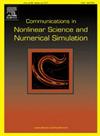类中心衰减振荡的幂律行为:基于微扰理论和优化的指数
IF 3.8
2区 数学
Q1 MATHEMATICS, APPLIED
Communications in Nonlinear Science and Numerical Simulation
Pub Date : 2025-04-18
DOI:10.1016/j.cnsns.2025.108844
引用次数: 0
摘要
在动力系统理论中,缺乏区分精确中心解和类衰减中心解的直接规则,因为两者都要求阻尼力函数为零(Sarkar 等,2011;Saha 和 Gangopadhyay,2018)。通过采用多尺度微扰方法,我们证明了衰减中心样幂律行为的一般规则,其特征是指数为 13。研究始于阻尼力函数中的高阶非线性物理问题,在向衰减中心型解法过渡时,阻尼力函数表现出双节律和三节律行为。利用数值优化算法,我们确定了各种节律条件下中心型衰减行为的幂律指数。在所有情况下,我们都观察到了指数为 13 的衰减幂律。我们的研究旨在阐明它们在动力学上的差异,从而为区分不同类型的中心样行为至关重要的理论见解和实际应用做出贡献。这一关键结果将有助于研究生物和工程系统的多节律特性。本文章由计算机程序翻译,如有差异,请以英文原文为准。
Power law behavior of center-like decaying oscillation: Exponent through Perturbation Theory and Optimization
In dynamical systems theory, there is a lack of a straightforward rule to distinguish exact center solutions from decaying center-like solutions, as both require the damping force function to be zero (Sarkar et al., 2011; Saha and Gangopadhyay, 2018). By adopting a multi-scale perturbative method, we have demonstrated a general rule for the decaying center-like power law behavior, characterized by an exponent of . The investigation began with a physical question about the higher-order nonlinearity in a damping force function, which exhibits birhythmic and trirhythmic behavior under a transition to a decaying center-type solution. Using numerical optimization algorithms, we identified the power law exponent for decaying center-type behavior across various rhythmic conditions. For all scenarios, we consistently observed a decaying power law with an exponent of . Our study aims to elucidate their dynamical differences, contributing to theoretical insights and practical applications where distinguishing between different types of center-like behavior is crucial. This key result would be beneficial for studying the multi-rhythmic nature of biological and engineering systems.
求助全文
通过发布文献求助,成功后即可免费获取论文全文。
去求助
来源期刊

Communications in Nonlinear Science and Numerical Simulation
MATHEMATICS, APPLIED-MATHEMATICS, INTERDISCIPLINARY APPLICATIONS
CiteScore
6.80
自引率
7.70%
发文量
378
审稿时长
78 days
期刊介绍:
The journal publishes original research findings on experimental observation, mathematical modeling, theoretical analysis and numerical simulation, for more accurate description, better prediction or novel application, of nonlinear phenomena in science and engineering. It offers a venue for researchers to make rapid exchange of ideas and techniques in nonlinear science and complexity.
The submission of manuscripts with cross-disciplinary approaches in nonlinear science and complexity is particularly encouraged.
Topics of interest:
Nonlinear differential or delay equations, Lie group analysis and asymptotic methods, Discontinuous systems, Fractals, Fractional calculus and dynamics, Nonlinear effects in quantum mechanics, Nonlinear stochastic processes, Experimental nonlinear science, Time-series and signal analysis, Computational methods and simulations in nonlinear science and engineering, Control of dynamical systems, Synchronization, Lyapunov analysis, High-dimensional chaos and turbulence, Chaos in Hamiltonian systems, Integrable systems and solitons, Collective behavior in many-body systems, Biological physics and networks, Nonlinear mechanical systems, Complex systems and complexity.
No length limitation for contributions is set, but only concisely written manuscripts are published. Brief papers are published on the basis of Rapid Communications. Discussions of previously published papers are welcome.
 求助内容:
求助内容: 应助结果提醒方式:
应助结果提醒方式:


